




Colorado Ave. + the Sea

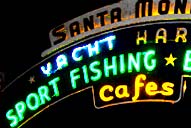
Santa Monica Pier sign at night
photo by Michael Grandcolas
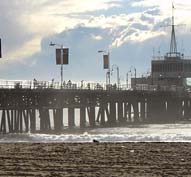
The sun reflecting on Santa Monica Pier
photo by Michael Grandcolas
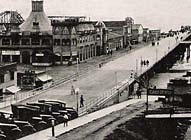
Early photo of The Looff and Santa Monica Piers, Santa Monica, CA
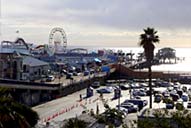
Current photo
photo by Michael Grandcolas
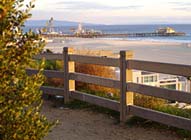
View from Palisades Park
photo by Michael Grandcolas
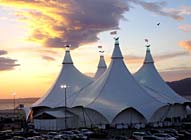
Events are commonly held in the
Pier parking lot
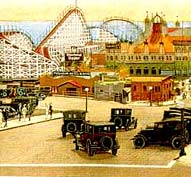
The La Monica Pier and Santa Monica Muncipal Pier - 1925
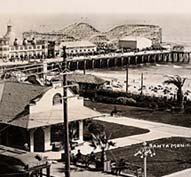
The Santa Monica Pier - photo 1921
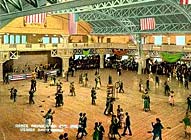
The Dance Hall's spacious floor could accommodate 800 couples
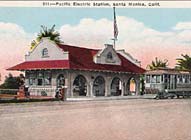
Pacific Electric Station
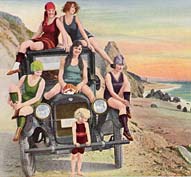
A Carload of Bathing Beauties
Santa Monica, CA
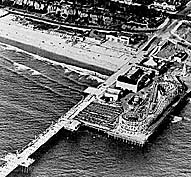
Aerial view of the Looff Pier - 1918
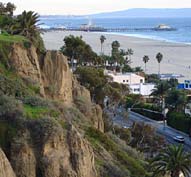
Pier from the Palisades, Where the Mountains Meet the Sea
photo by Michael Grandcolas
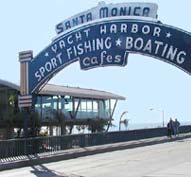
Santa Monica Pier sign
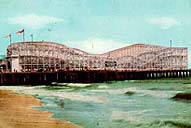
The Ben Hur Racer operated for 1 year before it burned in a fire
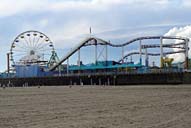
Coaster now on Santa Monica Pier
photo by Michael Grandcolas
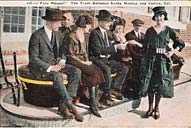
Fare Please - The Tram Between
Santa Monica and Venice CA
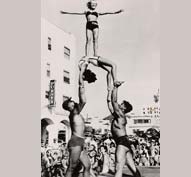
Muscle Beach
Abbot Kinney, from a well-to-do family from New Brunswick New Jersey, became interested in land development along the Los Angeles coast. In 1891 Kinney and his partner Francis Ryan bought controlling interest in the Ocean Park Casino and the surrounding tract of land. They built a beach resort called Ocean Park. Ocean Park Pier in the center of their resort at Pier Avenue opened in 1898.
Kinney developed a grander vision, The Venice Of America pleasure pier.
That’s when the City of Santa Monica got the vision of doing a municipal
pier. On September 9, 1909, after sixteen months of construction, the
Santa Monica Municipal Pier opened to the public. The City wrote it into
the budget by making it’s primary use to carry sewer pipes beyond
the breakers. The 1,600-foot-long wooden pier opened with festivities
and gala hoopla that included band concerts, swimming races and the novelty
of walking above the waters of the Pacific Ocean. Clean and austere, the
pier had no amenities.
The Pier's continuing ability to attract large crowds impressed entertainment
entrepreneur Charles Looff. Looff established his reputation on the East
Coast, having built Coney Island’s first Carousel in Brooklyn, NY
in 1876. He later moved his factory to Crescent Park in East Providence,
Rhode Island, where his showpiece carousel still operates.
Sensing vast potential for amusement attractions on the Southern California
coast, Looff moved his operations to Long Beach in 1910. When he began
to consider building a pleasure pier of his own, Santa Monica was his
location of choice.
In February 1916, Looff concluded lengthy negotiations with the City to purchase 200 feet of beachfront property for $50,000. He announced plans to build an amusement pier adjacent to the municipal pier that would be open later that summer. The "Santa Monica Pier" is actually two adjoining piers that long had separate owners. There’s the lengthy municipal pier and the short, wide southern Pleasure Pier (AKA Newcombs Pier), which was built in 1916 by Looff and his son Arthur.
The Looff Pier was an immediate attraction, featuring rides like "The Blue Streak Racer" roller coaster, the "Whip" and "Aeroscope" and a hippodrome housing a hand-carved merry-go-round.
In the early days of Santa Monica, when it was a summer seaside resort, there were numerous pleasure piers dotting the coastline - besides the Ocean Park Pier, the Venice of America Pier and the Santa Monica Municipal Pier sprouted up Fraser, Pickering and Lick Piers. Their development and demise of each is accompanied by a legacy of political squabbles and mysterious fires.
The piers were similar but unique, they were seaside carnival promenades featuring rides, booths, concessions, music and dancehalls, not to mention Venice’s renowned Seaside Plunge.
When the new and improved Pickering Pier opened June 18, 1920, 25,000
people came on Saturday and 60,000 people on Sunday. Business was great
that summer and Pickering paid his investors a 1% monthly dividend.
As Santa Monica evolved as a getaway destination, the Pier expanded to
meet people’s needs. In 1924, the elaborate La Monica Ballroom opened.
The La Monica Ballroom accommodated up to 10,000 elegantly attired dancers
and featured all the top entertainers of the time. In true Hollywood fashion,
it grew to become the site of some of the earliest national radio and
television broadcasts. Musical styles included Jazz, Big Bad and "Western
Swing."
Spending money became scarce once the Depression hit and number of visitors
to the Pier dropped. The “Blue Streak” was torn down in 1930.
1932 was the worst year of the Depression, but the area piers didn't recover
until the summer of 1935 when the Pacific Electric trolley fare was reduced
from 50 cents to 35 cents. To aid the revitalization of The Pier, in 1938
the federal Works Project Administration built the bridge to the pier
and the entry gate and replaced the former grade connection. The sign
was another new touch.
Renovations continued after World War II, but the amusement pier was out of fashion as a weekend destination. Young people staying home to watch television or driving their cars to outdoor movie theaters. Bingo games closed down in 1949, depriving the Piers of much of their income.
While the Municipal Pier continued to be owned and operated by the City
of Santa Monica, the Looff Pleasure Pier had a succession of owners. In
1953 it was taken over by the city, which leased it to a private operator.
In the 1960s various plans were floated that would have caused the loss
of the pier. The strangest one called for the construction of an artificial
island with a 1500-room hotel. It was actually approved by the City Council,
but citizens formed Save the Santa Monica Bay to preserve the pier. Please
click here for a first hand account on the effort to Save the Pier.
As the Santa Monica Conservancy recalls, “In 1973, an advocacy group
called ‘Save the Santa Monica Bay’ rallied to save the Santa
Monica Pier, which was slated for demolition. The City Council had been
under the impression that pleasure piers were outmoded styles of amusement
and that Disneyland satisfied the needs of local residents for a more
contemporary amusement park. Concerned residents convinced the City Council
that the Pier was an important piece of local history worthy of preservation
and restoration.
Citizens got the outstanding order to raze the Pier revoked by the City
Council in 1973, the same winter that the Ocean Park Pier was demolished.
The year it was saved the Santa Monica Pier and the Looff Hippodrome were
featured in the Paul Newman Robert Redford classic film “The Sting”.
For more information on movies made on the Pier click
here
In 1988, the Santa Monica Pier Development Program was adopted by Santa
Monica's City Council. As part of the Development Program, a new concrete
substructure added strength and stability to the Pier. A variety of retail,
food and entertainment outlets, a police substation and a new amusement
park were constructed on the Pier.
On Tuesday evenings in the summer the Pier hosts outdoor movies. On Thursdays,
it’s the celebrated "Twilight Dance Series.” Each year
features an eclectic mix world -renowned musicians in a free concert.
Currently, more than 3 million people visit the Pier each year. The Santa
Monica Pier continues its legacy as California’s oldest pleasure
pier and is the only pier with an amusement park on the West Coast.
**
A FIRST HAND ACCOUNT OF SAVING THE SANTA MONICA PIER BY BILL BAUER
“I'm writing all this because nobody gets the history of the Save
the Piers movement right. It's a slight to the many people who worked
very hard and gave money to "Save the Piers" to see other organizations
that were not involved take credit….
In early 1973, the Santa Monica City Council voted to demolish the Santa
Monica Pier(s) in order to build a "bridge" to an artificial
island proposed for the Santa Monica Bay. The island to be constructed
near the present breakwater would have featured a hotel and convention
center. The project with the work of then City Manager, Perry Scott and
supported by the Chamber of Commerce, real estate interest and developer
dominated City Council.
Public backlash against the proposal scuttled the plan however the majority
on City Council did not rescind the demolition order for the Santa Monica
Pier and adjoining Newcomb Pier. A number of citizens groups sprang up
to defend the Piers. The two largest were "Save the Piers Citizen
Committee" and "Friends of Santa Monica Pier."
Both committees, and other groups, pier businesses and individuals targeted
three councilmen who steadfastly refused to budge of the demolition order
and who were up for reelection in the spring. (one of these councilmen
was Bob Gabriel) All three were defeated and three pro-pier councilmen
were elected. Their first order of business was to rescind the demolition
orders.
Some of us (and I was associated with the STPCC) were concerned that a
future city council could vote to remove the piers so we asked the new
council persons to enact an ordinance making it a crime with fines for
anyone to tear down the Pier(s). They were reluctant to pass the ordinance
so a group of us got together and architect, Garth Sheriff and others
drafted an initiative called the "Pier Preservation Act."
The initiative and went on the ballot in 1975 or 1976. A group was formed,
collected signatures and qualified the proposal for the ballot in 1975
or 1976. The group made up of persons from both the old "Save the
Piers" and "Friends..." was called "The Citizen's
Initiative to Preserve the Piers" and the ballot measure was Prop
1. Our slogan: "Save the Piers, FOREVER." I managed the campaign
for passage of Prop 1 and it passed easily.
Some of us went on to form a group called the "Santa Monica Landmark
Protectors." The group was formed by the late Jack Sikking. Our first
mission was to save the old Spanish Revival style city library on 5th
and Santa Monica Blvd. The City had opened a new library building at 6th
and Santa Monica Blvd. (also since demolished), moved the library there
and sold the old property. That property had been purchased by a developer
who wanted to put up a ten story bank building with an above ground parking
structure toward the rear along 5th Street. He claimed the old library
had been irreparably damaged by the 1971 Sylmar earth quake. We failed
to save it, it was demolished and I think Cal Fed has the property now.
I dropped out of the "Landmark Protectors" at that point and
it's possible that others went on to become involved in Santa Monica's
landmark movement. Some of our people became involved in a movement to
divide the city into councilmanic districts, which failed. That led to
the creation of the renters rights movement in 1978/1979.
"Save the Santa Monica Bay" had nothing to do with the piers.
It was formed in (I believe) the early 1970s to fight an elevated, over
the water, multi-lane, vehicular causeway Cal Trans wanted to build right
off the coast to extend the Santa Monica Freeway up to Malibu. That project
was killed and "Save the Bay" hung around for years afterwards
doing the kind of work "Heal the Bay" does now.
Thanks.
Bill Bauer
**
LIGHTS CAMERA LOCATION - MOVIES MADE IN SANTA MONICA
By Jodi Summers
For sure, someone knows of a silent film or seven that were filmed in Santa Monica. But, the earliest known record of Santa Monica & Santa Monica residents being used in a movie was the1933 Laurel and Hardy classic Sons of the Desert. The film, which is about Ollie & Stan sneaking away to Chicago and attend the annual "Sons of the Desert" lodge convention, features the Santa Monica Lodge of Elks in a "movie" newsreel of the lodge's convention parade.
Since then, Santa Monica streets homes beaches and landmarks have been featured in a myriad of movies and television shows. Today, we're going to tell you about some of the movies that made Santa Monica famous. Do you know of some you wish to share email us -> [email protected]. We'll cover TV shows another day...
* In 1955 Santa Monica High School masqueraded as Dawson High in the James Dean, Natalie Wood classic, “Rebel Without A Cause.” In the film Dean plays a rebellious young man with a troubled past comes to a new town, finding friends and enemies. His school, Dawson high was supposed to be located at "University & 10th," not at Pico Boulevard & 4th Street.
* Santa Monica is featured in the 1963 slapstick production of, "It's a Mad Mad Mad Mad World." The film has a noteworthy cast that includes Spencer Tracy, Milton Berle, Buddy Hackett, Ethel Merman, Mickey Rooney, Zasu Pitts and Carl Reiner.
* The Looff Hippodrome carousel on the Santa Monica Pier was prominently featured in several films of the late 1960’s and early ‘70s. This includes the 1965 film "Inside Daisy Clover,” starring Natalie Wood and Robert Redford. Jane Fonda, the future first lady of Santa Monica filmed at the carousel in the 1969 move "They Shoot Horses, Don’t They?" Robert Redford again spent a lot of time hanging out around the Pier in 1973. This time it when Redford and Paul Newman were playing two con men trying to get even by pulling off a big con on the mob boss in the classic film "The Sting."
* Several filming locations around Santa Monica are featured in Sean Penn breakthrough film, 1982's "Fast Times at Ridgemont High," the teenage wasteland story of a group of California teenagers who enjoy malls, sex and rock n' roll.
* In 1984, Eddie Murphy, in the guise of Detroit detective Axel Foley, "Beverly Hills Cop" went pursuing a murder investigation with Judge Reinhold all over the West Side, Santa Monica included.
* And our honorable Governator again proves to be near and dear to Santa Monica. His 1991 film "Terminator 2: Judgment Day." Called "the best action film of all time" by some fans, the film features Arnold Schwarzenegger, Linda Hamilton, Edward Furlong, and Robert Patrick. Produced by James Cameron, this story of a shape-shifting cyborg and a protector sent back from the future to kill John Connor before he can grow up to lead the resistance. Parts of the mall scenes (the arcade, back hallways, and crashing through the window) were filmed at Santa Monica Place.
* When "Forrest Gump" was jogging across the USA in 1994, he jogged out on Santa Monica Pier. Forrest Gump, while not intelligent, has accidentally been present at many historic moments, but his true love, Jenny, eludes him.
* In 1994 the Main Street area got lots of exposure in the Keanu Reeves / Sandra Bullock / Dennis Hopper (Venice resident) high-action film "Speed.” Near the beginning of the film, a Santa Monica bus explodes, killing the driver. That explosion scene took place at the corner of Main Street & Rose Avenue. It immortalized that unique "Ballerina Clown" sculpture that sits on the façade of 255 Main Street.
* Bullock was back in our neighborhood filming "The Net," in 1995. This flick about computer espionage snot scenes along the Santa Monica Pier and lots of locations around Venice, including the Social and Public Resources Center, formerly the Venice division of LAPD located 685 Venice Boulevard.
* Bowfinger, the 1999 film with Steve Martin, Eddie Murphy, Heather Graham (a SaMoHi grad), had scenes filmed at Rae's Restaurant, 2901 Pico Boulevard. The film is about a movie producer going to great lengths to get a major star for his low budget production.
* The 2001 Jim Carrey movie, "The Majestic" about a blacklisted Hollywood writer who gets into a car accident, features scenes on the Santa Monica Pier.
* Perhaps Santa Monica is best documented in the 2001 release “Dogtown
and Z-Boys.”
The film, narrated by Sean Penn, follows the evolution of modern skateboarding
through its 70's heyday, its decline during the 80's, and its eventual
(and highly lucrative) return in the 90's. Starting from the California
surf community of Dogtown, This film features vintage footage of lots
of swimming pools, homes and streets around town, the beach the Boardwalk....
Santa Monica is Dogtown.
* Ocean Avenue and the Promenade were settings for the 2003 movie Freaky Friday - featuring local resident Jamie Lee Curtis as well as Lindsay Lohan in this story of the personality dynamic of a mother and her teenager. When they switch bodies, each is forced to adapt to the others life for one freaky Friday.
What movies do you know that have been filmed around town?
For your real estate needs, e-mail Jodi Summers at [email protected],
or call (310) 309-4219.